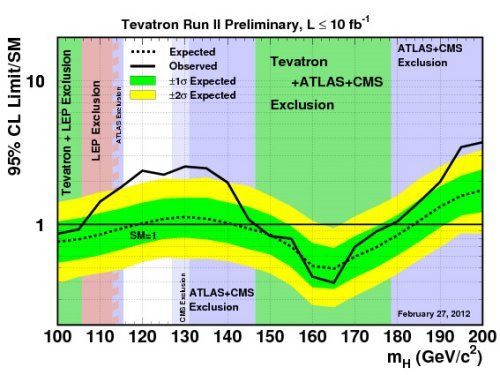
The latest results from the Tevatron. (Courtesy: Fermilab)
By Hamish Johnston
“The elusive Higgs boson may nearly be cornered”, that’s the rather vague message of a press release issued today by Fermilab. The release describes the analysis of data from the Tevatron’s two main experiments – CDF and DZero – that Fermilab claims sits well with previous attempts at finding the Higgs by the Tevatron, the Large Hadron Collider (LHC) and other accelerators.
The Fermilab results, along with information gleaned from other colliders including the LHC, are shown in the “Brazil band” plot above. While I don’t think that this latest announcement from the Tevatron is earth-shattering, the plot is a nice summary of where physicists are with the Higgs.
The horizontal axis is simply the mass of a hypothetical Higgs. The vertical axis is the ratio of the highest possible Higgs production rate compatible with data from the Tevatron divided by the production rate predicted by the Standard Model. Whenever this ratio (the solid curve) dips below one, the data exclude a Standard Model Higgs. The dashed line represents what is expected if the Higgs doesn’t exist. The green and yellow Brazil bands show the 1σ and 2σ uncertainties in the non-existence of the Higgs. If the solid line rises above the upper yellow band, it could be (very preliminary) evidence of the Higgs.
That’s why we should be mildly excited about the broad bump in the lower half of the mass range, which suggests that the Higgs could be in region of 115–140 GeV/c2.
In December, the two LHC experiments ATLAS and CMS found the strongest evidence yet of the Higgs – and the particle weighed in at about 125 GeV/c2. Therefore, this latest result jives with the tentative sighting by the LHC. However, the LHC bump appears to be much sharper – and is more statistically significant. If you want to know why (and much more), Matt Strassler gives his usual level-headed analysis here.
If more exuberant speculation is to your liking, Philip Gibbs has combined the Tevatron and LHC results to create nice bump, which you can see on his blog.
As well as backing up the growing belief that the Higgs mass is around 125 GeV/c2, this latest analysis also excludes the Higgs mass in the region 147–179 GeV/c2 – which widens the Tevatron’s previous exclusion of 156–177 GeV/c2.
The results were presented today at the Moriond Electroweak Conference in La Thuile in the Italian Alps.



